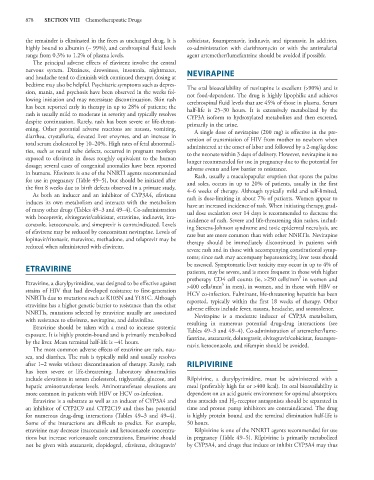Page 892 - Basic _ Clinical Pharmacology ( PDFDrive )
P. 892
878 SECTION VIII Chemotherapeutic Drugs
the remainder is eliminated in the feces as unchanged drug. It is cobicistat, fosamprenavir, indinavir, and tipranavir. In addition,
highly bound to albumin (~ 99%), and cerebrospinal fluid levels co-administration with clarithromycin or with the antimalarial
range from 0.3% to 1.2% of plasma levels. agent artemether/lumefantrine should be avoided if possible.
The principal adverse effects of efavirenz involve the central
nervous system. Dizziness, drowsiness, insomnia, nightmares, NEVIRAPINE
and headache tend to diminish with continued therapy; dosing at
bedtime may also be helpful. Psychiatric symptoms such as depres- The oral bioavailability of nevirapine is excellent (>90%) and is
sion, mania, and psychosis have been observed in the weeks fol- not food-dependent. The drug is highly lipophilic and achieves
lowing initiation and may necessitate discontinuation. Skin rash cerebrospinal fluid levels that are 45% of those in plasma. Serum
has been reported early in therapy in up to 28% of patients; the half-life is 25–30 hours. It is extensively metabolized by the
rash is usually mild to moderate in severity and typically resolves CYP3A isoform to hydroxylated metabolites and then excreted,
despite continuation. Rarely, rash has been severe or life-threat- primarily in the urine.
ening. Other potential adverse reactions are nausea, vomiting, A single dose of nevirapine (200 mg) is effective in the pre-
diarrhea, crystalluria, elevated liver enzymes, and an increase in vention of transmission of HIV from mother to newborn when
total serum cholesterol by 10–20%. High rates of fetal abnormali- administered at the onset of labor and followed by a 2-mg/kg dose
ties, such as neural tube defects, occurred in pregnant monkeys to the neonate within 3 days of delivery. However, nevirapine is no
exposed to efavirenz in doses roughly equivalent to the human longer recommended for use in pregnancy due to the potential for
dosage; several cases of congenital anomalies have been reported adverse events and low barrier to resistance.
in humans. Efavirenz is one of the NNRTI agents recommended Rash, usually a maculopapular eruption that spares the palms
for use in pregnancy (Table 49–5), but should be initiated after and soles, occurs in up to 20% of patients, usually in the first
the first 8 weeks due to birth defects observed in a primate study. 4–6 weeks of therapy. Although typically mild and self-limited,
As both an inducer and an inhibitor of CYP3A4, efavirenz
induces its own metabolism and interacts with the metabolism rash is dose-limiting in about 7% of patients. Women appear to
have an increased incidence of rash. When initiating therapy, grad-
of many other drugs (Tables 49–3 and 49–4). Co-administration ual dose escalation over 14 days is recommended to decrease the
with boceprevir, elvitegravir/cobicistat, etravirine, indinavir, itra- incidence of rash. Severe and life-threatening skin rashes, includ-
conazole, ketoconazole, and simeprevir is contraindicated. Levels ing Stevens-Johnson syndrome and toxic epidermal necrolysis, are
of efavirenz may be reduced by concomitant nevirapine. Levels of rare but are more common than with other NNRTIs. Nevirapine
lopinavir/ritonavir, maraviroc, methadone, and telaprevir may be therapy should be immediately discontinued in patients with
reduced when administered with efavirenz.
severe rash and in those with accompanying constitutional symp-
toms; since rash may accompany hepatotoxicity, liver tests should
ETRAVIRINE be assessed. Symptomatic liver toxicity may occur in up to 4% of
patients, may be severe, and is more frequent in those with higher
3
pretherapy CD4 cell counts (ie, >250 cells/mm in women and
Etravirine, a diarylpyrimidine, was designed to be effective against >400 cells/mm in men), in women, and in those with HBV or
3
strains of HIV that had developed resistance to first-generation HCV co-infection. Fulminant, life-threatening hepatitis has been
NNRTIs due to mutations such as K103N and Y181C. Although reported, typically within the first 18 weeks of therapy. Other
etravirine has a higher genetic barrier to resistance than the other adverse effects include fever, nausea, headache, and somnolence.
NNRTIs, mutations selected by etravirine usually are associated Nevirapine is a moderate inducer of CYP3A metabolism,
with resistance to efavirenz, nevirapine, and delavirdine. resulting in numerous potential drug-drug interactions (see
Etravirine should be taken with a meal to increase systemic
exposure. It is highly protein-bound and is primarily metabolized Tables 49–3 and 49–4). Co-administration of artemether/lume-
fantrine, atazanavir, dolutegravir, elvitegravir/cobicistat, fosampre-
by the liver. Mean terminal half-life is ~41 hours. navir, ketoconazole, and rifampin should be avoided.
The most common adverse effects of etravirine are rash, nau-
sea, and diarrhea. The rash is typically mild and usually resolves
after 1–2 weeks without discontinuation of therapy. Rarely, rash RILPIVIRINE
has been severe or life-threatening. Laboratory abnormalities
include elevations in serum cholesterol, triglyceride, glucose, and Rilpivirine, a diarylpyrimidine, must be administered with a
hepatic aminotransferase levels. Aminotransferase elevations are meal (preferably high fat or >400 kcal). Its oral bioavailability is
more common in patients with HBV or HCV co-infection. dependent on an acid gastric environment for optimal absorption;
Etravirine is a substrate as well as an inducer of CYP3A4 and thus antacids and H -receptor antagonists should be separated in
2
an inhibitor of CYP2C9 and CYP2C19 and thus has potential time and proton pump inhibitors are contraindicated. The drug
for numerous drug-drug interactions (Tables 49–3 and 49–4). is highly protein bound and the terminal elimination half-life is
Some of the interactions are difficult to predict. For example, 50 hours.
etravirine may decrease itraconazole and ketoconazole concentra- Rilpivirine is one of the NNRTI agents recommended for use
tions but increase voriconazole concentrations. Etravirine should in pregnancy (Table 49–5). Rilpivirine is primarily metabolized
not be given with atazanavir, clopidogrel, efavirenz, elvitegravir/ by CYP3A4, and drugs that induce or inhibit CYP3A4 may thus

